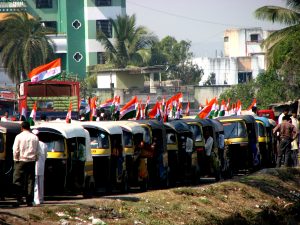As 968 million people head to polling booths across the nation, the Election Commission of India is going to great lengths to ensure that a “green election” is conducted. In the southern state of Kerala, for instance, the commission collaborated with the Local Self Government Department to ensure plastic-free polling. Election officials served tea in steel mugs instead of the standard paper cups with a thin plastic coating.
However, this attention to detail isn’t matched by political parties contesting the election. Or by voters, who don’t seem to care about climate change. The CSDS-Lokniti 2024 pre-poll survey indicates that Indian voters are primarily concerned with unemployment and inflation.
A detailed review of the election manifestos revealed that, except for the regional party Dravida Munnetra Kazhagam (DMK), none of the major political parties in India have concrete grassroots-level plans to mitigate the impact of climate change.
Unprecedented climate change disasters — prolonged heatwaves, flash floods, drought, agricultural devastation and landslides — are affecting people in India. Yet India’s electoral scene features only a modest and oblique reflection of issues related to climate change.
In forest-adjoining areas throughout the country, it’s increasingly common for wild animals to enter human settlements and cause damage. This is mostly caused by food and water shortages in summer and alterations in wildlife habitats because of climate change.
In the Wayanad constituency where Congress leader Rahul Gandhi is contesting, human-wildlife conflicts have already become a hot electoral issue. A poster on a street wall in a village on the Kerala-Tamil Nadu border read, “It is the people who vote in elections, not the animals that are encroaching into human settlements. Stop animal rule!”
Such sentiment arises from a prevalent anthropocentric worldview, where the state forest and wildlife departments are criticized for prioritizing animals over human beings.
In Lok Sabha constituencies in the Western Ghats, the authors observed that environmental concerns hardly influence electoral politics, despite the fact that the daily lives of people in those regions are closely intertwined with nature.
Perhaps the best illustration of this would be the popular protests a decade ago against the Madhav Gadgil–K. Kasturirangan committee reports. These reports aimed at safeguarding the ecologically fragile Western Ghats, a 1,600 km-long mountain range from Gujarat to Tamil Nadu, by restricting human construction and certain types of agriculture.
The inhabitants of the Western Ghats, which is identified as one of the world’s eight “hottest hotspots” of biological diversity, managed to win a Lok Sabha seat in the 2014 election with the support of left parties and succeeded in stopping the committee’s pro-environment recommendations from being implemented.
Even though the Western Ghats are one of the worst-hit areas in terms of climate change-triggered casualties, especially from landslides and agricultural loss, the electoral politics of the region largely revolve around conventional issues.
The attitude in the Western Ghats is in stark contrast to Europe, which votes in early June to elect the next European Parliament. A poll conducted by Euronews and Ipsos in 18 countries found that 52 percent of voters there prioritize the fight against climate change over other issues.
The so-called climate voters in Europe are mostly young people. One of the hot topics during elections is the European Green Deal, which aims to make the continent climate-neutral by 2050. A World Wildlife Fund survey showed that European political parties are particularly focused on combating climate change, as they “shared support for ending fossil fuel use, transitioning to 100 percent renewable energy, and adopting nature-based solutions to tackle climate change.”
In Europe, green parties, which have been actively pushing environmental issues since the 1970s, now hold a major share of the vote in many countries and are putting the climate agenda at the forefront of elections.
While not a key issue in the Lok Sabha elections, more extreme temperatures have begun to establish new standards for how Indian voters engage with and assess candidates during campaigning.
An incident encountered during fieldwork in a Lok Sabha constituency in South India, where there is a tight contest between two high-net-worth candidates from the Congress and BJP, illustrates this. A fruit seller devised his own “political thermometer” to compare candidates based on their body language during road shows. This campaign tool is less popular in the 2024 general elections due to rising temperatures.
“Just look at his downcast face, wearied under the sunlight. Is this AC-living guy going to speak for us in Parliament? Two days ago, the other candidate passed through this junction in an open jeep. As he did during previous elections, he stood energetically despite the scorching heat, raising his hands to the people with a smile,” the fruit seller said said.
In another constituency, people held high regard for an MP who spent hours wearing a local costume and coordinating rescue operations during floods.
Amid the climate crisis, the long-held expectation for any Indian politician to “be with the people” now also encompasses standing with them through their lived experiences of climate change.
However, Indian democracy is yet to breed a new category of “climate voters” as its electoral landscape is still conservative with practically very little space for environmental politics or green agendas.
Originally published under Creative Commons by 360info™.

































